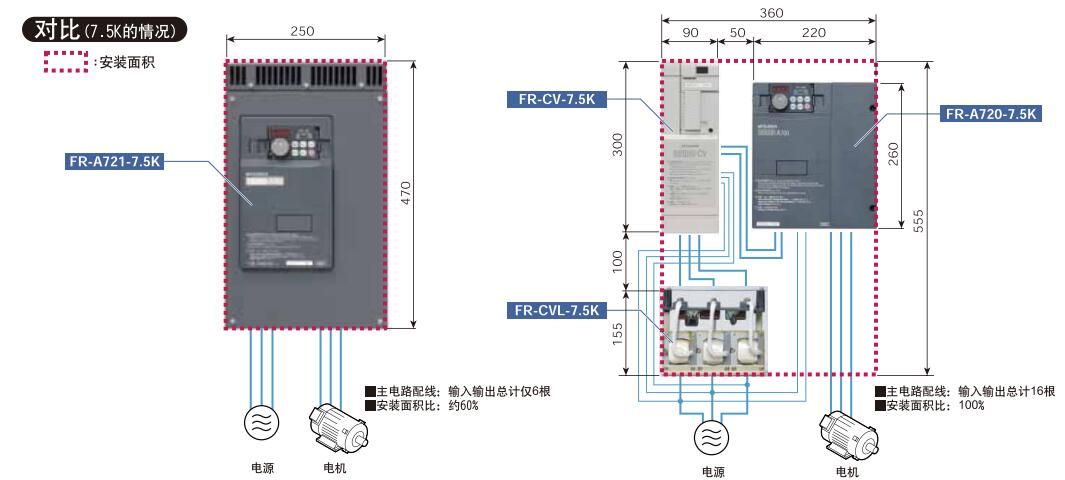Home
>> Products
>> MITSUBISHI
>> Inverter
>> Inverter accessories
>> FR-BLF | MITSUBISHI Line noise filter FR-BLF
FR-BLF | MITSUBISHI Line noise filter FR-BLF
MITSUBISHI FR-BLF Manual And Instructions
FR-BLF datasheetPDF datasheet
MITSUBISHI FR-BLF Product information and technical parameters:
Brand: MITSUBISHI
Name: Line noise filter
Model: FR-BLF
Used to reduce radio noise.
...More relevant models >>>>
FR-BLF datasheetPDF datasheet
MITSUBISHI FR-BLF Product information and technical parameters:
Brand: MITSUBISHI
Name: Line noise filter
Model: FR-BLF
Used to reduce radio noise.
MITSUBISHI inverter series: FR-F820.
Voltage level: three phase 200V.
Power: 0.75kw.
SLD converter rated current: 7.7A.
Structure and function: Standard model.
Type: CA.
Substrate coating: have.
Compatibility with existing models.
Transducer installation size and FR-F700 (P) series of the same, so you do not need to worry about the replacement operation MITSUBISHI FR-BLF.
(rectifier separation type will vary)
Also, but also through the use of options (FR-A8TAT), FR-F700 (P) series installed control loop terminal station FR-BLF
Built in 2 PID arithmetic. In the inverter can be PID control of the motor state at the same time, used in the control of the external machine.
No external PID controller is used to control the external machine, so the system cost can be reduced MITSUBISHI FR-BLF. MITSUBISHI inverter series: FR-F820.
Voltage level: three phase 200V.
Power: 30kw.
SLD converter rated current: 154A.
Structure and function: Standard model.
Type: CA.
Substrate coating: have.
PID target value can be set directly from the operator panel. Flexible change settings.
In the 1 inverter, through the PID control of parallel connection pump (up to 4 units) can adjust the amount of water and so on MITSUBISHI FR-BLF.
1 pumps driven by parallel connection of the pump machine, in addition to the pump for power frequency drive.
The number of power frequency driven pump, according to the automatic adjustment of water.
The liquid crystal panel options (FR-LU08) can be converted to a more intuitive display unit% units.
Through the use of wind, temperature and other familiar units can be simple to maintain and adjust the display. MITSUBISHI inverter series: FR-F840.
Voltage level: three phase 400V.
Power: 22.0kw.
SLD converter rated current: 47A.
Structure and function: Standard model.
Type: CA.
Substrate coating: have.
2 times the power consumption of the wind turbine and pump and the speed of the 3 power consumption is proportional to the speed of the rotating speed.
Through the speed control of the frequency converter to adjust the air flow, can reduce the ppower consumption FR-BLF.
Give full play to the performance of the motor.
The excitation current is always adjusted to the best state, which can improve the efficiency of the motor.
Load torque is smaller, can further improve energy efficiency.
For example, when a general motor is used, the optimal excitation control mode in the 4% motor load torque is about 30% more than that of the V/F control FR-BLF.
Voltage level: three phase 200V.
Power: 0.75kw.
SLD converter rated current: 7.7A.
Structure and function: Standard model.
Type: CA.
Substrate coating: have.
Compatibility with existing models.
Transducer installation size and FR-F700 (P) series of the same, so you do not need to worry about the replacement operation MITSUBISHI FR-BLF.
(rectifier separation type will vary)
Also, but also through the use of options (FR-A8TAT), FR-F700 (P) series installed control loop terminal station FR-BLF
Built in 2 PID arithmetic. In the inverter can be PID control of the motor state at the same time, used in the control of the external machine.
No external PID controller is used to control the external machine, so the system cost can be reduced MITSUBISHI FR-BLF. MITSUBISHI inverter series: FR-F820.
Voltage level: three phase 200V.
Power: 30kw.
SLD converter rated current: 154A.
Structure and function: Standard model.
Type: CA.
Substrate coating: have.
PID target value can be set directly from the operator panel. Flexible change settings.
In the 1 inverter, through the PID control of parallel connection pump (up to 4 units) can adjust the amount of water and so on MITSUBISHI FR-BLF.
1 pumps driven by parallel connection of the pump machine, in addition to the pump for power frequency drive.
The number of power frequency driven pump, according to the automatic adjustment of water.
The liquid crystal panel options (FR-LU08) can be converted to a more intuitive display unit% units.
Through the use of wind, temperature and other familiar units can be simple to maintain and adjust the display. MITSUBISHI inverter series: FR-F840.
Voltage level: three phase 400V.
Power: 22.0kw.
SLD converter rated current: 47A.
Structure and function: Standard model.
Type: CA.
Substrate coating: have.
2 times the power consumption of the wind turbine and pump and the speed of the 3 power consumption is proportional to the speed of the rotating speed.
Through the speed control of the frequency converter to adjust the air flow, can reduce the ppower consumption FR-BLF.
Give full play to the performance of the motor.
The excitation current is always adjusted to the best state, which can improve the efficiency of the motor.
Load torque is smaller, can further improve energy efficiency.
For example, when a general motor is used, the optimal excitation control mode in the 4% motor load torque is about 30% more than that of the V/F control FR-BLF.
...More relevant models >>>>
 Last one: MITSUBISHI Line noise filter FR-BSF01
Last one: MITSUBISHI Line noise filter FR-BSF01 next one: MITSUBISHI 16 bit digital output module FR-A7AX
next one: MITSUBISHI 16 bit digital output module FR-A7AX
Related download

